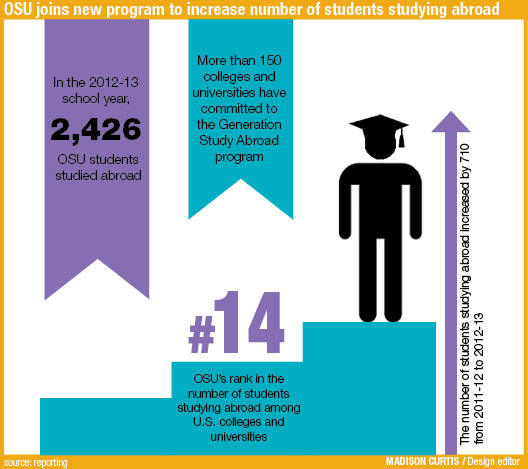Ohio State is slated to embark on a journey to increase the number of students studying beyond U.S. borders.
OSU has joined Generation Study Abroad, an Institute of International Education effort to double the number of U.S. students studying abroad by 2019, according to the Office of International Affairs website.
Of the approximately 2.6 million students graduating with associates or baccalaureate degrees every year, about 295,000 studied abroad in the 2011-12 academic year, representing about 11.3 percent of graduates, according to the IIE website.
OSU ranked No. 14 in the number of students who studied abroad among colleges and universities in U.S., according to the OIA website.
Maureen Miller, director of communication at OIA, said 2,426 OSU students studied abroad in 2012-13, and added the totals aren’t yet available for the 2013-14 year.
Compared with the numbers for 2011-12, 710 more students studied abroad in 2012-13, according to statistical highlights provided by Miller, something she said is because of several factors.
“The increase … can be attributed to the advent of May Session, giving students a new opportunity to study abroad,” Miller said in an email. “Some 570 students studied abroad during May Session 2013.”
May Session was created as a result of OSU’s conversion to semesters. The four-week long May Session was combined with a seven-week long Summer Session to comprise Summer Term. OSU offered students up to three free credit hours during May Session to encourage enrollment last year and is set to do the same this May. Those hours can be used toward study abroad programs during May Session, according to the OSU Student Service Center website.
U.S. First Lady Michelle Obama encouraged students to study abroad in an address Monday that was in support of President Barack Obama’s 100,000 Strong Initiative, which aims to increase the number of American students who study abroad in China.
“The fact is, with every friendship you make, and every bond of trust you establish, you are shaping the image of America projected to the rest of the world. That is so important. So when you study abroad, you’re actually helping to make America stronger,” she said, according to a White House press release.
Michelle Obama also said she understands how some students feel they can’t afford to study abroad.
“Maybe they may feel like study abroad is something that only rich kids do, or maybe kids who go to certain colleges,” she said. “I felt that same way back when I was in college. I grew up in a blue-collar neighborhood on the South Side of Chicago, and the idea of spending time abroad just never registered with me … So we know that it’s not enough for us to simply encourage more people to study abroad. We also need to make sure that they can actually afford it.”
Those efforts are set to come in the form of shorter study abroad programs and scholarships, according to the White House release.
Some OSU students said they enjoyed studying abroad.
“It’s an eye-opening experience because I got to experience a different culture on my own without feeling a constraint of being a tourist with a large group of people,” said Priscilla Chau, a second-year in chemistry who studied abroad in England during winter break.
Thamar Plute, a second-year in international studies and Korean, said studying abroad in South Korea in summer 2013 allowed him to build relationships with new people.
“The relationships you have with people are the foundation for everything else in life,” Plute said. “To understand culture, to learn, to solve problems require us to have a foundation of understanding each other.”
Caitlin King, a study abroad coordinator at OIA, said her time studying in Brazil in summer 2012 improved her foreign language skills.
“I couldn’t have learned it if I did not leave the United States,” King said.
OSU has developed some strategies to increase the number of students that study outside of the U.S. borders, including continuing to promote new Global May programs during May Session to attract first-year and second-year students of all majors, planning a partnership with the Second-Year Transformational Experience Program and aiming to enroll more students from a variety of different colleges in abroad programs, according to OIA’s website.
STEP coordinates second-year students with faculty members in an attempt to enhance the students’ experience as a facet of the university’s plan to require all second-years to live on campus starting fall 2016.
Besides OSU, more than 150 colleges and universities have committed to the program, according to the OIA website.



